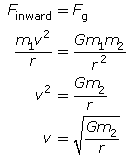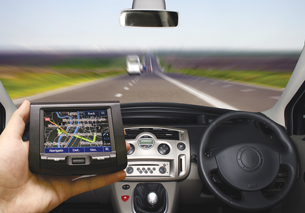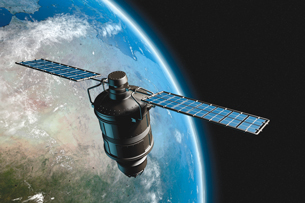Module 5—Circular Motion
 Module Summary
Module Summary
When an object travels in a circular path, there is an inward force that causes the direction of the motion to change. The inward force can be friction, tension, gravitational, and so on. The magnitude of the force is related to the mass of the object, radius of the circle, and speed of the object.
Inward (centripetal) force can be mathematically described by the relationship between the velocity, mass, and radius of an object rotating in a horizontal plane. Expressed as an equation, it is
![]()
Quantity |
Symbol |
SI Unit |
inward (centripetal) force |
Finward |
N |
mass |
m |
kg |
radius of circular path |
r |
m |
speed |
v |
m/s |
Applying Newton’s second law to the equation for centripetal force gives the following expression for centripetal acceleration:

The situation becomes more complicated when gravity acts on an object that follows a vertical circular path. You can use free-body analysis to understand the net inward force and tension acting on such an object.
At the top of the vertical circle, the tension acting is described by
![]() , where g = +9.81 m/s2
, where g = +9.81 m/s2
If the tension reaches zero at the top of the arc, the object is in a momentary state of free fall. The speed at which this will occur is described by

At the bottom of the vertical circle, the tension acting is greater because it opposes the force due to gravity.
![]() , where g = +9.81 m/s2
, where g = +9.81 m/s2
From this analysis, you will be able to determine the acceleration acting on an object or rider at any point in the vertical circle, leading to a better understanding of the causes of the sensations experienced when moving in vertical circles.
Kepler’s three laws describe the motion of the planets as they orbit the Sun.
- Kepler's first law stated the orbit of a planet around the Sun is an ellipse, with the Sun located at one of the two focal points of the ellipse.
- Kepler's second law stated that in equal time intervals, the radius vector from the Sun to a planet sweeps across equal areas.
- Kepler's third law stated that for all planet orbits, the square of the period is proportional to the cube of the semi-major axis (the mean distance from the Sun or mean orbital radius). Expressed as an equation, it is

Newton’s universal law of gravitation and the principles of circular motion can be applied to explain the observed motion of planets and satellites.
Equating the inward force and the universal law of gravitation gives an expression for the velocity of an orbiting planet or satellite.

Equating Newton’s second law and the universal law of gravitation gives an expression for the inward acceleration of an orbiting planet or satellite.


By determining the velocity and the acceleration of an orbiting planet or satellite, it is possible to explain the observed orbital motion, which is accurately described by Kepler’s three laws.
Module 5 Assessment
The assessment for Module 5 consists of four (4) assignments, as well as a final module inquiry project.
- Module 5: Lesson 1 Assignment
- Module 5: Lesson 2 Assignment
- Module 5: Lesson 3 Assignment
- Module 5: Lesson 4 Assignment
- Module 5 Project
Module 5 Project: Global Positioning Satellites
This module project is based on an understanding of global positioning systems (GPS) and how they relate to circular motion, gravitational fields, and the past and future impacts of technology on society.

© Olaru Radian-Alexandru /shutterstock
Global positioning systems are proliferating in our society in many ways. Cell phones, cars, pet tags, and other applications are evolving to incorporate this technology. Applications, such as "arrive alive," will allow cell-phone position, movements, and whereabouts to be tracked in real time. Imagine parents monitoring where their children are at all times, being notified if the phone travels outside a "boundary" or if the motion of the phone is in a vehicle that exceeds the local speed limit. These are issues that are being discussed now, and they are all related to satellite technology that is based on circular motion and gravitational fields. In fact, if you have a cell phone, you are already carrying this technology.
Project Tasks
This inquiry project involves four major questions with two related tasks in each.
- How is GPS technology used to solve problems?
- Investigate where GPS applications are being used, noting societal issues that have "popped-up" as a result of their applications.
- Create a list of applications or problems that GPS technology could be used to solve.
- Investigate where GPS applications are being used, noting societal issues that have "popped-up" as a result of their applications.
- How does GPS work?
- Research the network of satellites that are used to power the current world GPS system, and describe how this technology functions.
- Report on the orbital specifications of the GPS satellites. For example, report about the mass, altitude, and orbital period of GPS satellites.
- Research the network of satellites that are used to power the current world GPS system, and describe how this technology functions.
- Describe how principles of circular motion determine the orbital path of a satellite.
- Given a satellite's mass and orbital altitude, how is the speed of the satellite determined?
- How is a satellite's speed and altitude related to the launch vehicle requirements?
- Given a satellite's mass and orbital altitude, how is the speed of the satellite determined?
- How does Earth's gravitational field cause the orbital path of the satellite?
- Determine the acceleration due to gravity at the GPS satellite's orbital altitude using Newton's universal law of gravitation.
- Relate the orbital acceleration to the velocity as a verification using Finward = Fg.
- Determine the acceleration due to gravity at the GPS satellite's orbital altitude using Newton's universal law of gravitation.
Submitting Your Project

© Cristi Matei/shutterstock
Your project must be submitted as a computer presentation using the software of your choice (e.g., PowerPoint, Word, HTML, PDF).
Your presentation will include a simulation of the GPS orbital path that verifies your calculations. You may use the Weight and Orbits simulation used in Lesson 4, or you may create this simulation using other technologies.
Your presentation will include answers to the four major questions posed under Project Tasks.
Your presentation should conclude by explaining how orbital knowledge supports the infrastructure for new technologies and their application in solving both old and new problems.
Be sure to include a reference page listing all of your research sources for this project. List all web pages, books, and magazine articles you use.
Research
Begin your research by searching the Internet for the phrase “Global Positioning System GPS.”
You might also want to search for a tutorial on GPS.
How Will Your Project be Assessed?
You will be marked according to the following guidelines. You will be graded for your work answering the four major questions listed under Project Tasks.
1. How is GPS technology used to solve problems? |
|||
1: Poor |
2: Satisfactory |
3: Good |
4: Excellent |
The project suggests applications that are unrelated to the technology or are not new. |
The project suggests only a few limited applications, some not new. |
The project explains multiple applications of GPS and suggests new and unique applications. |
The project applies GPS to new applications and begins to identify risks and benefits. |
2. How does GPS work? |
|||
1: Poor |
2: Satisfactory |
3: Good |
4: Excellent |
The project demonstrates a lack of research and understanding of the technology. |
The project demonstrates a basic understanding of the technology with some research. |
The project demonstrates a solid understanding of the technology with relevant research. |
The project demonstrates a solid understanding of the technology with exemplary research. |
3. Describe how principles of circular motion determine the orbital path of a satellite. |
|||
1: Poor |
2: Satisfactory |
3: Good |
4: Excellent |
The project does not apply relevant physics concepts. |
The project applies basic equations to describe one aspect of circular motion. |
The project applies all equations with some errors and misconceptions. |
The project applies all equations to completely describe the motion of a satellite. |
4. How does Earth's gravitational field cause the orbital path of the satellite? |
|||
1: Poor |
2: Satisfactory |
3: Good |
4: Excellent |
The project does not apply Newton's laws to the motion. |
The project applies one of Newton's laws for a basic explanation of the orbit. |
The project applies all of Newton's laws correctly to explain the motion of the satellite. |
The project applies and shows manipulation and substitution of Newton's laws to explain the motion of the satellite. |
You will also be graded for the presentation and delivery of your Module 5 Project.
1: Poor |
2: Satisfactory |
3: Good |
4: Excellent |
The project presents content in a text-based document only. |
The project presents content in multimedia form with limited discussion and explanation. |
The project presents content in multimedia form with discussion and use of a simulation. |
The project presents content in multimedia form with discussions, supporting documents, a simulation, and suggestions for further study and application. |
Total available marks = 20 marks x 3 (weighting) = 60 marks